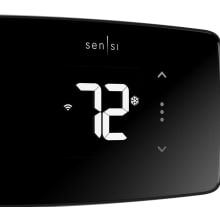Pros
-
Compatible with Amazon Alexa, Google Assistant, and Samsung SmartThings
-
Option to prevent rapid AC system switching
-
Intuitive interface
Cons
-
You can't program a schedule on the unit itself
-
No push-in connectors
-
Needs batteries to operate
About The Sensi Lite Smart Thermostat

The Sensi's packaging comes with instructions and QR codes to help you download the app and pair it. Once you do, the app will walk you through how to get your thermostat set up and wired.
- Smart home assistants: Amazon Alexa, Google Assistant, and Samsung SmartThings
- C-wire: Recommended, but will operate with a four wire minimum
- Colors: Black
- Dimensions: 5.07 x 3.13 x .88 inches
- Connectivity: 2.4 and 5GHz Wi-Fi
The Sensi Lite is an entry-level offering from Copeland’s Sensi brand. It features a black square frame with rounded edges that has more or less the same shape and profile as a traditional thermostat. Rather than a touchscreen, it has touch sensitive buttons for controls.
For optimal functionality the thermostat will require a C-wire; however, its minimum wiring is four wires, with one of the other wires repurposed for power. The thermostat also contains a battery slot for two included AA batteries.
The Sensi connects to smart home systems via both Wi-Fi and Bluetooth. During setup it will ask you to scan a QR code to connect the unit to the app.
How we tested the Sensi Lite Smart Thermostat
Dave Ellerby, Reviewed’s chief scientist, tested the Sensi Lite Smart Thermostat.
We attached the thermostat to a test rig that simulates a heating and cooling system. With this system, when the thermostat switched to heat a red light came on; when it switched to cool a blue light came on. It was also attached to a small fan, which triggered when the thermostat activated the fan wire.
We measured temperature accuracy using a National Institute of Standards and Technology calibrated Thermometer.
What we like
Intuitive controls and scheduling help you save on energy bills

Sensi’s app experience is easy to use from first contact, whether you're scheduling, adjusting default temperature settings, or simply checking the current temperature.
A smart thermostat doesn’t have to be a labyrinth of menus. Many of us want a thermostat that will do what it’s supposed to do (save on energy bills and resources) without adding in a bunch of smart features that don’t have much to do with an HVAC system.
The Sensi Lite Smart Thermostat is simple in design and intuitive to use. App controls give you control over scheduling and basic functions whether you’re in or out of the house. The thermostat’s scheduling will assume a nine to five, but you can customize this.
The Lite also has simple geofencing, which will monitor the location of a connected device and adapt accordingly. When enabled, it sets your thermostat back three degrees when it senses that the connected device is three miles away from home.
A standard cogwheel in the top of the thermostat yields controls for temperature units, upper and lower temperature limits, and more specific options like a button to prevent the air conditioning unit from repeatedly switching on and off in a way that could damage its compressor.
It’s simple to set up and widely compatible

From physical installation to Wi-Fi setup, the Sensi App will guide you, making this a truly DIY friendly thermostat.
The Sensi Lite’s form factor is basic, but this means that it often fits right into the place where an old traditional thermostat would have been—no spackle work needed.
While it will work best with a dedicated C-wire for power, it is possible to get this running with just four wires. It even includes a battery (reminiscent of traditional thermostats) to keep things running in case of short breaks in power.
The app guides you through install and set up, even providing help with wiring. This is great for DIYers that don’t want to work too hard. Connect it to Wi-Fi and you’ll have it synced with your smart speaker in no time.
The Sensi app is available on both iOS and Android. Additionally, the system is compatible with multiple smart assistants.
Dehumidification is there, even if it’s just overcooling
When you get to playing with your Sensi’s controls you’ll notice a dehumidification mode. Unless you’ve hooked up a dehumidifier, this control will use your home’s AC unit to reduce temperature by a few degrees. Because cooler air holds less humidity this will decrease overall humidity.
Dehumidifying this way works, but it’s confusing and it will also run your AC more than you might want.
What we don’t like
Its basic design doesn't appeal to most
This looks a bit like the 1990s programmable thermostat box that came with your home’s HVAC system. As far as smart home devices go it’s basic in its design and feature set.
The Sensi Lite doesn’t have the responsive touch screen you’d get on higher end models, or voice commands built in; rather, its physical controls are limited to touch buttons. Further, many of the device’s controls are inaccessible from the physical interface. More complex tasks will require you to use the app.
For about the same price, the Nest Thermostat not only has a touchscreen, but it’s well laid out and gives you a superior level of control.
Sensing accuracy is a little wonky
Most consumers won’t feel or notice this, but in our tests the Sensi Lite was consistently off temperature from our NIST thermometer by a degree or so. This isn’t a big deal, but it is worth noting.
It goes looking for rebates

Expect pop ups asking you to look for utility savings.
Energy companies often award rebates to incentivize switching to energy saving smart thermostats. Whether for rebates or basic energy savings, one of the best reasons to get a smart thermostat is to save energy and cut down on energy bills.
That said, we don’t like a thermostat to be pushy.
When fully set up, the Sensi prompts you to connect to energy companies in your area and get connected to them, so that you can look for any available rebates. Doing this will probably save you money, but it’s aggressive in execution and feels like pop up ads (think notorious McAfee virus protection pop ups).
Should you buy the Sensi Lite Thermostat
Maybe, if you're looking for an effective entry-level smart thermostat that doesn't require a C-wire

With simple buttons instead of a touch screen, it might not be the pinnacle of high-tech, but this smart thermostat is still smart enough for the average homeowner.
If you want simplicity, then the Sensi may very well have everything you need. It doesn’t have fancy features like a voice assistant built in, or give you access to adaptive schedules that will monitor local energy prices. Consequently, it doesn’t get bogged down in labyrinthine menus or confuse you with lots of extra options.
That same simplicity also detracts. The physical controls are basic enough to be hard to use. Also, Sensi’s claims about getting around a C-wire overstate the situation—that functionality isn’t uncommon.
The Sensi is far more affordable than the most advanced thermostats out there; however, it competes with the Nest Thermostat, the entry-level version of Google’s Nest Learning Thermostat. At a similar price, the entry Nest Thermostat offers more, including a touchscreen with better control, a more advanced Eco mode, and a similar ability to get around a lack of a C-wire.
For most, the Nest will be a better choice. However, if you want a system that puts intuitive app controls and simple set up above all else, then this is the one.

This affordable smart thermostat offers an intuitive system that’s widely compatible and can skip the C-wire.
Meet the testers

Gabriel Morgan
Staff Writer, Home
Gabriel Morgan is a staff writer on Reviewed's home team, where he covers consumer education topics such as earthquake preparedness, radon in the home, and concerns about health and wellness in product design. He also writes product reviews and how-to articles on appliances, smart home technology, and goods for the home.

Dr. Dave Ellerby
Chief Scientist
Dave Ellerby has a Ph.D. from the University of Leeds and a B.Sc. from the University of Manchester. He has 25+ years of experience designing tests and analyzing data.
Checking our work.
Our team is here to help you buy the best stuff and love what you own. Our writers, editors, and experts obsess over the products we cover to make sure you're confident and satisfied. Have a different opinion about something we recommend? Email us and we'll compare notes.
Shoot us an email



